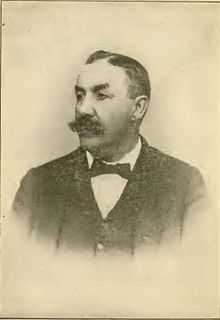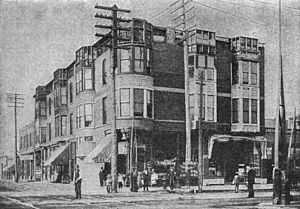Frank Geyer
| Frank Geyer | |
|---|---|
 | |
| Born | July 28, 1853 |
| Died | October 4, 1918 (aged 65) |
Frank Geyer (July 28, 1853 – October 4, 1918) was an American detective from Philadelphia, Pennsylvania, best known for arresting H H Holmes, one of the first known serial killers of the United States. Geyer was a member of the famed Pinkerton detective agency and caught Holmes while working on what would be known as the Holmes-Pitezel Case. He published the story in his book, The Holmes-Pitezel Case: a history of the greatest crime of the century and of the search for the missing Pitezel children.[1]
In the 2003 bestselling book The Devil in the White City Frank Geyer is described as a "big man with a pleasant, earnest face".[2] His wife and daughter were killed in a fire a short time before he started investigating the Holmes case.[3]
Son of Reuben K. Geyer and Camilla Buck, Frank Geyer died at the age of 65 due to complications from heart disease and his funeral was attended by hundreds of policemen and detectives.[4]
The Holmes-Pitezel Case
H H Holmes's recorded crimes began in Chicago in 1893 when he opened a hotel called The World’s Fair Hotel for the World's Columbian Exposition. The structure, built by Holmes, would later be known as the ‘Murder Castle’ because of the labyrinthine constructions on the top two floors, which he used to torture and kill many of his victims. In a 1937 article, the Chicago Tribune described: “There were rooms that had no doors. There were doors that had no rooms. A mysterious house it was indeed -- a crooked house, a reflex of the builder's own distorted mind. In that house occurred dark and eerie deeds.”[5]

The Pinkertons first apprehended Holmes in 1894 in Boston on an outstanding warrant for insurance fraud perpetrated in Philadelphia. Frank Geyer was tasked with investigating and the trail led him through the mid west and Toronto, Canada, where he found the remains of two of the Pitezel children.[6] They were the children of Benjamin Pitezel, Holmes's former partner in crime, which he had murdered in order to commit life insurance fraud. Pitezel, however, was only involved in fraud and had no knowledge of the murders.
The initial investigation was concerned with the insurance fraud but it soon became apparent that Holmes killed Pitezel. In June 1895 Frank Geyer left Philadelphia to retrace Holmes’s steps. His findings in Toronto led to further investigations of Holmes’s Chicago property, which sealed his fate. Geyer used information from the unsent letters written by the Pitezel children which, for an unknown reason, were kept by Holmes. In Toronto, he found the bodies of Alice and Nellie Pitezel. He continued his search and found the burnt remains of Howard Pitezel, the third child, in a house Holmes had rented in Irvington, Indianapolis.[7]
Holmes was found guilty of four counts of murder in the first degree and six counts of attempted murder and executed in May 1896 at the age of 34. His total number of victims is estimated at around 200.[8]
That same year Frank Geyer published his book detailing the case. He described the story as "one of the most marvellous [sic] stories of modern times".[3]
References
- ↑ Geyer, Frank P.; Lawrence J. Gutter Collection of Chicagoana (University of Illinois at Chicago) ICIU (1896). The Holmes-Pitezel case; a history of the greatest crime of the century and of the search for the missing Pitezel children. Philadelphia. Retrieved 2014-12-16.
- ↑ Erik Larson (2003). The Devil in the White City: Murder, Magic, and Madness at the Fair That Changed America. Crown. ISBN 978-0-609-60844-9.
- ↑ 3.0 3.1 Katherine Ramsland. "H. H. Holmes: Master of Illusion". Crime Library - Criminal Minds & Methods. Retrieved November 24, 2014.
- ↑ "Franklin P "Frank" Geyer". Find a Grave. Retrieved November 24, 2014.
- ↑ Benzkofer, Stephan (October 24, 2014). "Chicago's first serial killer". The Chicago Tribune.
- ↑ David Wencer. "Historicist: H.H. Holmes in Toronto". Torontoist. Retrieved November 24, 2014.
- ↑ Darcia Helle. "The Monstrous H.H. Holmes and His Murder Castle Inc.". All Things Crime Blog. Retrieved November 24, 2014.
- ↑ John Bartlow Martin. "The Master of Murder Castle: A Classic of Chicago Crime". Harper's Weekly. Retrieved November 24, 2014.